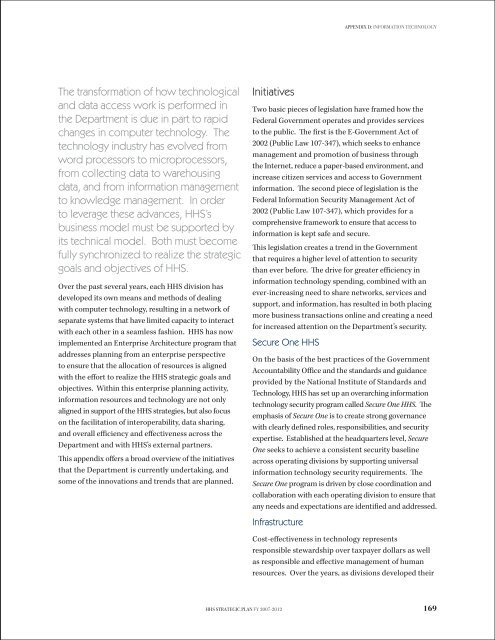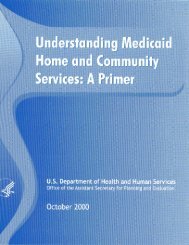STRATEGIC PLAN - ASPE - U.S. Department of Health and Human ...
STRATEGIC PLAN - ASPE - U.S. Department of Health and Human ...
STRATEGIC PLAN - ASPE - U.S. Department of Health and Human ...
You also want an ePaper? Increase the reach of your titles
YUMPU automatically turns print PDFs into web optimized ePapers that Google loves.
Appendix d: information technologyThe transformation <strong>of</strong> how technological<strong>and</strong> data access work is performed inthe <strong>Department</strong> is due in part to rapidchanges in computer technology. Thetechnology industry has evolved fromword processors to microprocessors,from collecting data to warehousingdata, <strong>and</strong> from information managementto knowledge management. In orderto leverage these advances, HHS’sbusiness model must be supported byits technical model. Both must becomefully synchronized to realize the strategicgoals <strong>and</strong> objectives <strong>of</strong> HHS.Over the past several years, each HHS division hasdeveloped its own means <strong>and</strong> methods <strong>of</strong> dealingwith computer technology, resulting in a network <strong>of</strong>separate systems that have limited capacity to interactwith each other in a seamless fashion. HHS has nowimplemented an Enterprise Architecture program thataddresses planning from an enterprise perspectiveto ensure that the allocation <strong>of</strong> resources is alignedwith the effort to realize the HHS strategic goals <strong>and</strong>objectives. Within this enterprise planning activity,information resources <strong>and</strong> technology are not onlyaligned in support <strong>of</strong> the HHS strategies, but also focuson the facilitation <strong>of</strong> interoperability, data sharing,<strong>and</strong> overall efficiency <strong>and</strong> effectiveness across the<strong>Department</strong> <strong>and</strong> with HHS’s external partners.This appendix <strong>of</strong>fers a broad overview <strong>of</strong> the initiativesthat the <strong>Department</strong> is currently undertaking, <strong>and</strong>some <strong>of</strong> the innovations <strong>and</strong> trends that are planned.InitiativesTwo basic pieces <strong>of</strong> legislation have framed how theFederal Government operates <strong>and</strong> provides servicesto the public. The first is the E-Government Act <strong>of</strong>2002 (Public Law 107-347), which seeks to enhancemanagement <strong>and</strong> promotion <strong>of</strong> business throughthe Internet, reduce a paper-based environment, <strong>and</strong>increase citizen services <strong>and</strong> access to Governmentinformation. The second piece <strong>of</strong> legislation is theFederal Information Security Management Act <strong>of</strong>2002 (Public Law 107-347), which provides for acomprehensive framework to ensure that access toinformation is kept safe <strong>and</strong> secure.This legislation creates a trend in the Governmentthat requires a higher level <strong>of</strong> attention to securitythan ever before. The drive for greater efficiency ininformation technology spending, combined with anever-increasing need to share networks, services <strong>and</strong>support, <strong>and</strong> information, has resulted in both placingmore business transactions online <strong>and</strong> creating a needfor increased attention on the <strong>Department</strong>’s security.Secure One HHSOn the basis <strong>of</strong> the best practices <strong>of</strong> the GovernmentAccountability Office <strong>and</strong> the st<strong>and</strong>ards <strong>and</strong> guidanceprovided by the National Institute <strong>of</strong> St<strong>and</strong>ards <strong>and</strong>Technology, HHS has set up an overarching informationtechnology security program called Secure One HHS. Theemphasis <strong>of</strong> Secure One is to create strong governancewith clearly defined roles, responsibilities, <strong>and</strong> securityexpertise. Established at the headquarters level, SecureOne seeks to achieve a consistent security baselineacross operating divisions by supporting universalinformation technology security requirements. TheSecure One program is driven by close coordination <strong>and</strong>collaboration with each operating division to ensure thatany needs <strong>and</strong> expectations are identified <strong>and</strong> addressed.InfrastructureCost-effectiveness in technology representsresponsible stewardship over taxpayer dollars as wellas responsible <strong>and</strong> effective management <strong>of</strong> humanresources. Over the years, as divisions developed theirHHS Strategic Plan FY 2007-2012169
















